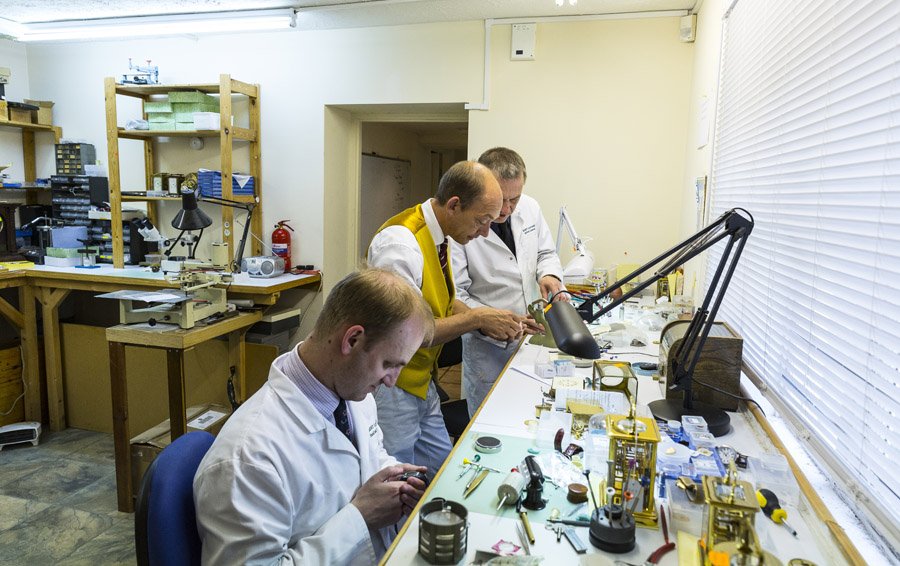Growing up in a family business steeped in horology, Robert Loomes was surrounded by clocks and watches and by tales of namesake Thomas Loomes, the eminent 17th century horologist who ran London’s largest firm of clock and watchmakers.
With a background predominantly in repair and restoration, Robert, who served a traditional apprenticeship under his father Brian Loomes before taking up the reins to follow in his father’s footsteps, was convinced it was possible to design, sketch and manufacture every component required to create an English watch.
Despite being told it was an impossible task, Robert set about creating a workshop and a team of watchmakers who could produce a watch from scratch under one roof. Each component is carefully sketched by hand, before starting the meticulous process of turning a sketch into machined components.
“We’re a firm of repairs and restorers. I grew up in the family business doing clockmaking and about 15 years ago I made a couple of watches myself, partly to tease a customer who had brought in a Swiss watch which he had paid £15,000 for. I gently pulled his leg saying I could make something like that for a fraction of the price and that what he had bought was an awful lot of marketing and a little bit of watch. He said ‘don’t be ridiculous you can’t do that’ and I did it to prove a point really.
“I made a pair of watches, one for me and one for him. When he saw them, he said we shouldn’t be repairing watches, but that we should be making them. So, we started, very tentatively, making watches; we imported bits and pieces – cases, dials, hands – built them all together and we had made a watch. It wasn’t overly difficult.”
The company sold a lot of watches in a short space of time and the business got noticeably bigger. It moved premises, brought in new staff and Robert’s partner Robina Hill took over as managing director, leaving him free to pursue research and development.
“Very quickly after taking over, Robina said that it’s not enough to make watches, as other people make watches, and what we needed to do was to make British watches; that’s what people would pay for – if it was made in this country, people would buy it. So I listened to her.
“She was told it was impossible to build an entirely British-made watch, but we knew we had the machinery, and we knew we had the skills.
“We produced the first ones really quickly in about two years; that was from the original germ of an idea to very old-fashioned drawings on graph paper and making a prototype, to producing the final watch.”
But Robert had a problem: “All of the machinery we had was manual and we needed a decent CNC milling machine to make smaller components ourselves rather than permanently farming out to other workshops around us. It becomes expensive having to outsource almost every component to someone else.”
So, the company built its own bespoke kit using a cheap milling machine, stripping it down and rebuilding it to meet their own specifications. It’s by no means of a commercial machine standard that can be run six days a week, 15 hours a day but Robert says for them, the speed of producing components is not as important as accuracy – so running a little slower isn’t an issue.
At less than £90,000 to build and set up, the bespoke machine cost a fraction of the price compared with buying a high-end, commercial machine which would have been in the region of £600,000.
After being used to make prototype parts, the CNC machine was put on pause for a few years but Robert was keen to bring it back into use and approached the University of Sheffield Advanced Manufacturing Research Centre (AMRC) for help re-commissioning the machine and giving staff the skills needed to operate it.
Robert said: “Watchmaking is a small world. There are only a handful of English watchmakers altogether, and many have led the way in research and development by going to experienced machinists and engineers rather than watchmakers.
“We did the same – we had an experienced mechanic build the machine for us, we had someone with a PhD in advanced manufacturing who came and worked for us and ran it for a couple of years for us. But neither of them were watchmakers.
“I’m the technical director so while I know how to use the machine, I rarely get days at a time to sit down in front of it and get on with it. We wanted to find the right sort of person to come and work with us who could do that role, someone who was a qualified watchmaker who liked machining and had some experience of CNC.
“That’s the right person for the job because they understand what the finished component needs to be and needs to do. They know which parts are critical in terms of measurement and which are immaterial. To give that type of person the right skills means we get so much more out of them.
“We’ve now got that person with us and through the help of the AMRC and Emma, we‘ve been able to give that person the basic skills they need to operate the machine. They’re now running experiments of their own and working out what different tools work best with certain materials.”
To find out more about Loomes & Co visit: www.robertloomes.co.uk






